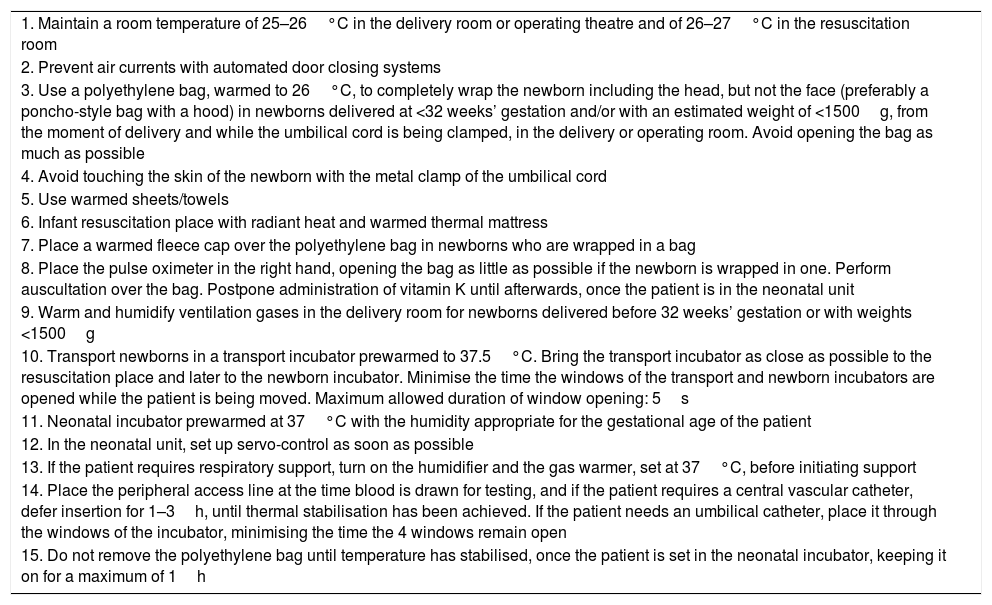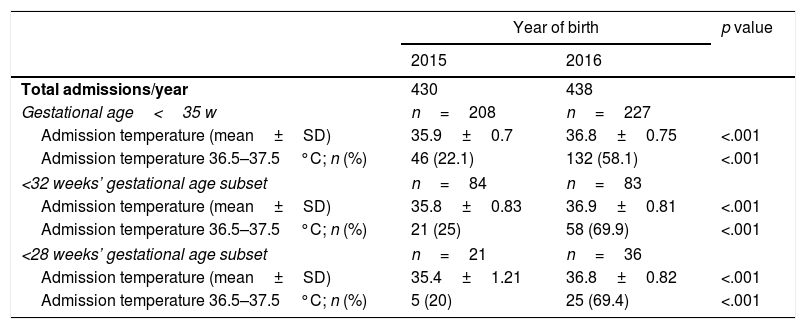Postnatal stabilisation is a key aspect of the beginning of extrauterine life. The latest recommendations of the International Liaison Committee on Resuscitation (ILCOR, 2015)1 and the Group on Neonatal Resuscitation of the Sociedad Española de Neonatología (Spanish Society of Neonatology, SENeo)2 underscore the importance of maintaining a body temperature within the normal range (36.5–37.5°C) in all newborns that are not experiencing asphyxia. Compared to adults, newborns need a higher temperature in the environment to maintain their body temperature, especially if they have been born preterm or in a compromised condition. Body temperature at admission in the neonatal unit is a predictor of morbidity and mortality and is especially relevant in extremely preterm newborns.3 Hypothermia causes hypoxia, metabolic acidosis, increased breathing difficulty and hypoglycaemia, and has been associated with an increased incidence of late-onset sepsis, retinopathy of prematurity, bronchopulmonary dysplasia, necrotising enterocolitis and intraventricular haemorrhage.1–5 It has been reported that in preterm newborns with birth weights less than 1500g, for every degree Celsius that the admission temperature decreases below 36.5°C, mortality increases by up to 28% and the risk of late-onset sepsis by up to 11%.3 Given the dire consequences of hypothermia, resuscitation guidelines recommend early and effective interventions to prevent it in newborns.1,2,6 It is also important to avoid hyperthermia (a body temperature>38°C), as it has been associated with increased respiratory depression, neonatal seizures, early mortality and cerebral palsy.1,2
The admission temperature of the patient must be recorded in the health record and is considered a health care quality indicator.
After reviewing the records of our hospital and finding that this recommendation was rarely met, in January 2016 measures were introduced to prevent decreases in body temperature in the delivery room and the first hour post birth, which are detailed in Table 1. All the involved staff were informed of the proposed improvement measures (obstetricians, midwives, neonatologists, anaesthesiologists, nurses, health care technicians and maintenance staff). One year after introducing these measures, we conducted an observational study in which we reviewed the axillary temperatures recorded at admission in the health records of newborns delivered before 35 weeks’ gestation. We excluded patients transferred from other hospitals. We defined normothermia as an axillary temperature of 36.5–37.5°C.
Measures implemented to prevent body temperature decreases in the first hour post birth.
| 1. Maintain a room temperature of 25–26°C in the delivery room or operating theatre and of 26–27°C in the resuscitation room |
| 2. Prevent air currents with automated door closing systems |
| 3. Use a polyethylene bag, warmed to 26°C, to completely wrap the newborn including the head, but not the face (preferably a poncho-style bag with a hood) in newborns delivered at <32 weeks’ gestation and/or with an estimated weight of <1500g, from the moment of delivery and while the umbilical cord is being clamped, in the delivery or operating room. Avoid opening the bag as much as possible |
| 4. Avoid touching the skin of the newborn with the metal clamp of the umbilical cord |
| 5. Use warmed sheets/towels |
| 6. Infant resuscitation place with radiant heat and warmed thermal mattress |
| 7. Place a warmed fleece cap over the polyethylene bag in newborns who are wrapped in a bag |
| 8. Place the pulse oximeter in the right hand, opening the bag as little as possible if the newborn is wrapped in one. Perform auscultation over the bag. Postpone administration of vitamin K until afterwards, once the patient is in the neonatal unit |
| 9. Warm and humidify ventilation gases in the delivery room for newborns delivered before 32 weeks’ gestation or with weights <1500g |
| 10. Transport newborns in a transport incubator prewarmed to 37.5°C. Bring the transport incubator as close as possible to the resuscitation place and later to the newborn incubator. Minimise the time the windows of the transport and newborn incubators are opened while the patient is being moved. Maximum allowed duration of window opening: 5s |
| 11. Neonatal incubator prewarmed at 37°C with the humidity appropriate for the gestational age of the patient |
| 12. In the neonatal unit, set up servo-control as soon as possible |
| 13. If the patient requires respiratory support, turn on the humidifier and the gas warmer, set at 37°C, before initiating support |
| 14. Place the peripheral access line at the time blood is drawn for testing, and if the patient requires a central vascular catheter, defer insertion for 1–3h, until thermal stabilisation has been achieved. If the patient needs an umbilical catheter, place it through the windows of the incubator, minimising the time the 4 windows remain open |
| 15. Do not remove the polyethylene bag until temperature has stabilised, once the patient is set in the neonatal incubator, keeping it on for a maximum of 1h |
In the previous 8 years (2008–2015), the mean axillary temperature at admission and the percentage of patients admitted with a normal temperature were similar, so we only show the results for 2015. Table 2 compares a retrospective cohort of patients born at gestational ages of less than 35 weeks in 2015 with another prospective cohort of infants born in 2016, when the improvement measures aimed at maintaining normothermia in the first hour of life had already been introduced. We performed the statistical analysis with the SPSS® package version 20.0. We compared means using the Student t test for independent samples and percentages with the chi square test. We defined statistical significance as a p-value of 0.05 or less.
Admission temperature in patients born before 35 weeks’ gestational age in 2015 and 2016.
| Year of birth | p value | ||
|---|---|---|---|
| 2015 | 2016 | ||
| Total admissions/year | 430 | 438 | |
| Gestational age<35 w | n=208 | n=227 | |
| Admission temperature (mean±SD) | 35.9±0.7 | 36.8±0.75 | <.001 |
| Admission temperature 36.5–37.5°C; n (%) | 46 (22.1) | 132 (58.1) | <.001 |
| <32 weeks’ gestational age subset | n=84 | n=83 | |
| Admission temperature (mean±SD) | 35.8±0.83 | 36.9±0.81 | <.001 |
| Admission temperature 36.5–37.5°C; n (%) | 21 (25) | 58 (69.9) | <.001 |
| <28 weeks’ gestational age subset | n=21 | n=36 | |
| Admission temperature (mean±SD) | 35.4±1.21 | 36.8±0.82 | <.001 |
| Admission temperature 36.5–37.5°C; n (%) | 5 (20) | 25 (69.4) | <.001 |
In years 2015 and 2016, 54.7% of admitted patients had been born before 35 weeks’ gestation. In 2015, the mean axillary temperature at admission was 35.9°C±0.7°C, and only 20.9% of these patients had a normal body temperature at admission. However, in year 2016, after the introduction of the improvement measures, the percentage of patients admitted with a normal temperature rose to 58.1%, and the mean admission temperature to 36.8°C, differences that were statistically significant. In the subset born before 32 weeks’ gestation, a group in which neonatal resuscitation guidelines emphasise the importance of maintaining normothermia, the impact of the improvement measures was even greater, with the target temperature range achieved in 70% of cases. This percentage was also achieved in the subset corresponding to the most vulnerable premature babies, those born before 28 weeks’ gestation.
The increase of the percentage of preterm patients admitted with a normal temperature is attribute to the awareness of the whole staff about the vulnerability of these patients adn their strict adherence to the adopted improvement measures. Nevertheless, we believe we ought to emphasise the importance of pursuing normothermia in all newborns without asphyxia, independently of gestational age.
In conclusion, we confirmed that the measures introduced to prevent decreases in body temperature in the delivery room and the first hour post birth have been effective. In spite of the improvement observed, it is necessary to continuous our efforts in order to achieve normothermia at admission in all newborns.
Please cite this article as: Herranz Barbero A, Sánchez Ortiz E, Salvia-Roigés MªD, Cortés Albuixech R, Rodríguez-Miguélez JM. Optimización de medidas para evitar el enfriamiento en la primera hora de vida de los prematuros menores de 35 semanas de gestación. An Pediatr (Barc). 2018;89:252–254.
Previous presentation: this study was presented as an oral communication at the XXVI Congreso de Neonatología y Medicina Perinatal – VI Congreso de Enfermería Neonatal; September 27–29, 2017; Zaragoza, Spain.







